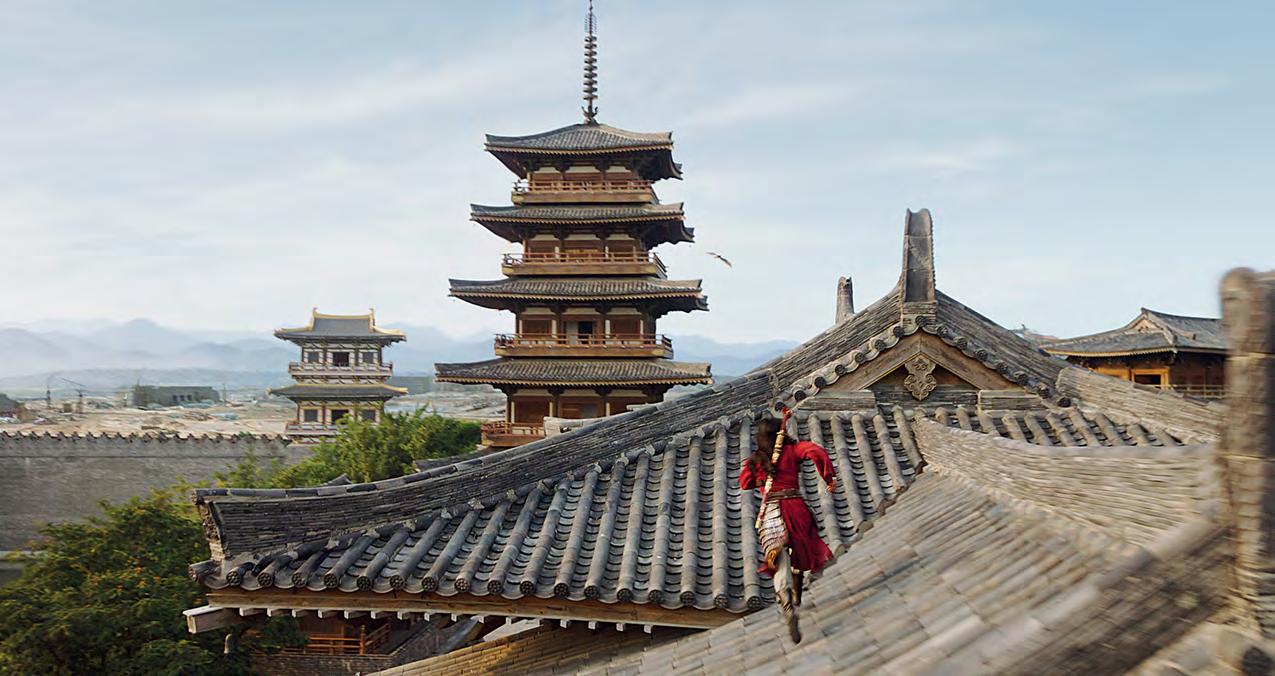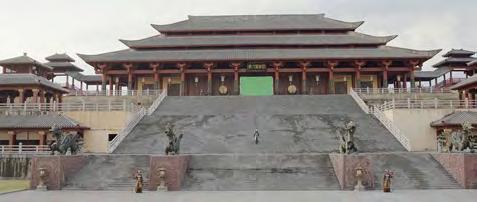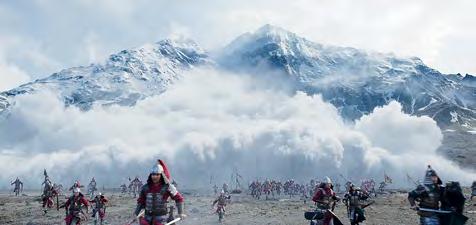
13 minute read
FILM: MULAN
WARRIOR PRINCESS RIDES AGAIN IN LIVE-ACTION MULAN
By TREVOR HOGG

Director Niki Caro
Images copyright © 2019 Disney Enterprises, Inc. Going from an independent film produced in New Zealand on a budget of $3.5 million to a Hollywood adaptation with a production cost of $200 million, director Niki Caro has kept things in perspective and has retained the same ethos for Mulan, the live- action re-make of the 1998 Disney animated film, that she had when making her international breakthrough Whale Rider (2002).
“I got to work with all of the best tools in the toolbox on this one,” says Caro. “I loved every second of it and being able to stretch my filmmaking to this genre and scale. But the storytelling is exactly the same.”
Caro had previously worked with special and visual effects, but nothing at this massive scale before. “No, but, boy, was that latent within me. I was provided an opportunity by Disney to show them my vision, and was given a team of people and previs. The first thing that I did was previs the biggest sequence in the film.”
In order to repel the invading Rourans, the Chinese Imperial Army conscripts one male per family, which causes Hua Mulan (Liu Yifei) to take the place of her father by posing as a man.
“I was leery of visual effects,” admits Caro. “I’m an in-camera girl, and the film was built more like Lawrence of Arabia than Marvel. We were out in real landscapes, had real horses charging across real battlegrounds, and real actors and stunt people.”
Recruited to be the Visual Effects Supervisor on the production was Sean Faden (Power Rangers). “The wonderful thing about Sean as a member of the team,” says Caro, “is that he’s an artist, as all of my heads of departments are. Sean appreciated and embraced
the need for visual effects to be subtle and integrated into the real world. In the visual effects realm, you can do so much, and it was up to me and Sean to get our vendors to pull it back in line with the real cinematic approach of the movie.”
About 2,046 visual effects shots were produced by Weta Digital, Sony Pictures Imageworks, Image Engine, Framestore, Crafty Apes and an in-house team. “Grant Major [production designer] and Niki chose parts of New Zealand that could be seen as Chinese landscape, and then anything we wanted to look more [authentically] Chinese, especially all of the shooting in the Imperial City, we went to a backlot in China and shot there for three weeks with second unit,” states Visual Effects Producer Diana Giorgiutti.
“This is the only time I’ve had a year in post,” she adds. “Having that extra time for the Phoenix [Mulan’s spiritual guide] was a blessing, because there are versions of the cut that are entirely different to where we landed in the end. The Phoenix is only in 19 shots versus close to 100 of them. The Phoenix now is a much more

OPPOSITE TOP: The rooftop chase was a combination of second unit footage captured at Xiangyang Tangcheng Film and Television Base in China, and the main unit shooting closeups of Mulan (Liu Yifei) against greenscreen at Kumeu Film Studios in New Zealand.
TOP: Steam was an important element in depicting a bloodless but visceral battle sequence.
MIDDLE LEFT TO RIGHT: Sean Faden, Visual Effects Supervisor
Diana Giorgiutti, Visual Effects Producer
Anders Langlands, Visual Effects Supervisor, Weta Digital
Christian Irles, Visual Effects Supervisor, Image Engine
Hubert Maston, Visual Effects Supervisor, Framestore
Seth Maury, Visual Effects Supervisor, Sony Pictures Imageworks
Rpin Suwannath, Previs Supervisor, Day for Nite
Cody Hernandez, Postvis Supervisor, Day for Nite
“I was leery of visual effects. I’m an in-camera girl, and the film was built more like Lawrence of Arabia than Marvel. We were out in real landscapes, had real horses charging across real battlegrounds, and real actors and stunt people.” —Niki Caro, Director


TOP: A gully was created by Sony Pictures Imageworks to absorb most of the impact of the avalanche as well as help with the integration of the Double Cone Mountains with the Ahuriri Valley.
BOTTOM: Weta Digital replaced most of the dirty stairs and added a full CG palace and city around the young soldier.


mythical creature that guides Mulan, which is right. Originally, it was much more comic.”
In wuxia martial arts movie tradition, Böri Khan (Jason Scott Lee) and the Rouran soldiers leap off of their horses and run up the wall of the desert garrison. “There was a lot of wire rigs work to get people up on the walls,” notes Faden. “We settled on a 20-degree slope that they ran up against a greenscreen and ended up rolling our world around them. We did a bunch of takes, but the winner was the one that had the best stunt performance for Böri Khan and the guy right in front of him. The other two guys in the back, we ended up doing some adjustments on them. Because they were literally jumping off of moving sleds onto a partial wall, most of that shot was CG aside from their performance. We replaced the wall because it wasn’t as detailed as our digital asset. We ended up doing a face replacement for Jason Scott Lee as well.”
A massive environment build was the Imperial City based on Chang’an, which was one of largest cities in the world during the 6th century. “We looked at historical maps of the city to figure out size and shape, how the different districts were broken down into individual wards and how those were populated with buildings, and where the richer and poorer areas would have been,” explains Weta Digital Visual Effects Supervisor Anders Langlands. “We looked at things like where high-ranking government officials were living, and deciding that’s where the richer parts of the city were and populating those with bigger and more refined buildings. All of our buildings had a poor, middle-class and rich version. Then we would use those to construct compounds that they sat in, at different sizes, based on how wealthy we assumed the area to be, and that fit into the procedural layout system that our layout team built in Houdini, which was able to quickly fill the whole city with buildings and put walls around the wards, all laid out according to this plan based on the structure of the real city. The system was able to adapt to things, like if you wanted to change the path of the river then it could re-populate the buildings automatically based on where the river was going or if we wanted to extend the city.”
Not all of the visual effects were epic in scope, such as the matchmaker scene when a tiny spider interrupts a tea ceremony with comedic results. “The spider was the first sequence that we had to deliver in entirety for [biennial Disney exposition event] D23 last August,” remarks Image Engine Visual Effects Supervisor Christian Irles. “It helped us get our act together and get everything working. Sean spent tons of time prevising and postvising every single shot, so by the time we got the sequence, we had a good indication of the starting and end points of the spider on every single shot. The way we approached all of those shots was using the postvis as a reference for the onscreen position of the spider. Match move every shot, run it through layouts to make sure it was in the right position in the environment, and hand it to animation to make sure they added a nice polishing and character to the spider.”
Framestore was responsible for most of the training sequence, which features Mulan going up a mountain with buckets filled with water on a stick. “That was a lot of world-building trying to create this gigantic wall that is around her,” admits Framestore Visual
Effects Supervisor Hubert Maston. “One of the things that was always a priority for Niki was everything had to look epic. You have to have the feeling that you have thousands of soldiers coming in to train in that camp. They had to be integrated into a large-scale environment and at the same time not constantly be a small speck of color on the screen. We had to make sure that nothing in the background or midground or around Mulan distracted from her. The live element that we had was mostly around the characters. We used a lot of drone footage for the far backgrounds and matte paintings.”
Transporting Mulan in and out of battle is her trusted steed Black Wind. “Sean told me when we first met, ‘I like to do the ‘Pepsi Challenge.’ You put your asset right next to the real thing and if we can’t tell the difference then we’re good to go,’” remarks Sony Pictures Imageworks Visual Effects Supervisor Seth Maury. “There was some second unit footage of a stunt rider on the Black Wind horse and we used that. We rotomated that horse and animated a run cycle to match with what that horse was doing. We have a new hair system called Fiber, which is essentially a more interactive hair placement tool where you can put down guide curves and see the result of all of the other hair in real-time. We chose slow-motion 6K footage of Black Wind running full speed down a canyon and matched the lighting. It went over well. The only way that you could tell it wasn’t a practical horse is that ours didn’t have a rider because we never built the CG Mulan. We had some new in-house tools to do muscle simulations with and great CFX to simulate the saddle and reins. We paid a lot of attention to the small details.”
Previs and postvis were completed by Day for Nite. “The nice thing about this one is the previs process was director-driven,” states Day for Nite Previs Supervisor Rpin Suwannath. “We would do the previs and have a review with Niki and all of the department heads. It wasn’t like we were trying to anticipate or guess what Niki wanted. She would be there to field all of the questions.”
The lower portion of the bamboo palace was an outdoor set, while the top section was shot on a soundstage. “You always have to think about where they are spinning on the beam because the sun is only one way in the world,” remarks Day for Nite Postvis Supervisor Cody Hernandez. “For me that was a challenge because I had to make sure that the artists were constantly talking to each other about where their shot was and the next shot was so that the sun placement on certain posts were in the right direction. We ended up redoing that sequence three or four times completely.”
‘Cloth Fu’ moments happen when the sleeves of the Witch (Gong Li) grab hold of an opponent. “Because her outfit was designed with big sleeves, stunts saw that and thought, ‘How can we use this?’” recalls Giorgiutti. “They had plastic bags, cloth and dust flipping around with basic After Effects work to pitch it all. Niki loved the idea. That was never in the original script.”
Special effects led by Steve Ingram (Ghost in the Shell) made significant contributions with the avalanche sequence by building a horse rig for Mulan and a blue conveyor belt for when Honghui (Yoson An) gets swept away by an ice chunk flow. “We had to design the avalanche so it would lose some of its deadliness before “[Visual Effects Supervisor] Sean [Faden] told me when we first met, ‘I like to do the ‘Pepsi Challenge.’ You put your asset right next to the real thing and if we can’t tell the difference then we’re good to go.’” —Seth Maury, Visual Effects Supervisor, Sony Pictures Imageworks


TOP: Along with being responsible for recreating the Imperial City, Weta Digital produced the CG hawk into which the Witch (Gong Li) transforms.
BOTTOM: The battle sequence which occurs in the middle of the movie was the focus of a 14-minute pitchvis presented by filmmaker Niki Caro to Disney studio executives.








“The biggest challenge on this was finding a tone with the visual effects that could support the grand scope of the photography and expand it when necessary. A long time was spent gathering photography and drone reference in China that are actual shots in the movie. We would enhance the China footage to make it feel more period-correct and give it the expanse that it didn’t have in the original photography.” —Sean Faden, Visual Effects Supervisor
it got to the Chinese army that was still running away from it,” reveals Faden. “The solution for that was to create a big gully at the base of the hill that it descends down. When the avalanche reaches the bottom, it shoots up and a lot of that energy is dissipated upward, but there is still flow of ice and debris that has momentum and is pushing forward.”
A particular scene always gets Giorgiutti teary-eyed. “There’s a moment where Mulan realizes that truth is more important and strips off all of her armor as she rides down a canyon on Black Wind back into battle. Mulan doesn’t care about the fact that she is probably going to be expelled from the army but wants to support her comrades. It is amazing.”
Making sure that the visual effects furthered rather than distracted from the storytelling was critical. “The biggest challenge on this was finding a tone with the visual effects that could support the grand scope of the photography and expand it when necessary,” notes Faden. “A long time was spent gathering photography and drone reference in China that are actual shots in the movie. We would enhance the China footage to make it feel more periodcorrect and give it the expanse that it didn’t have in the original photography. Visual effects wouldn’t have been able to get through what we had to get through without having the trust of Niki and Mandy [Walker].”
TOP TO BOTTOM: Mulan (Liu Yifei) takes the place of her conscripted father in the Imperial Army by posing as his son.
A soft and fluffy snow was settled upon by Sony Pictures Imageworks for the avalanche sequence.
Böri Khan (Jason Scott Lee) leads the Shadow Warriors against the Imperial Army.
One of the things that was always a priority for filmmaker Niki Caro was that everything had to look epic.
Framestore was responsible for doing set extensions and increasing the number of soldiers for the training sequences.
The hometown of Mulan (Liu Yifei) was a combination of footage shot at Xiaochun Tulou, China, and set footage captured in New Zealand.











